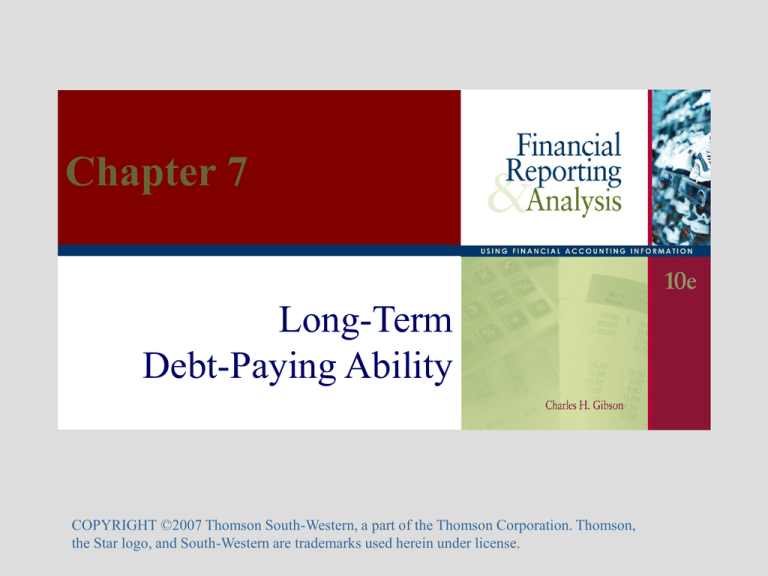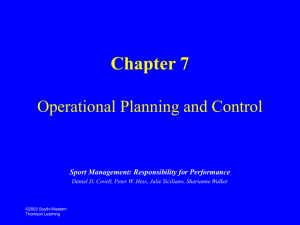
Chapter 7
Long-Term
Debt-Paying Ability
COPYRIGHT ©2007 Thomson South-Western, a part of the Thomson Corporation. Thomson,
the Star logo, and South-Western are trademarks used herein under license.
Times Interest Earned
Recurring Earnings, Excluding Interest
Expense, Tax Expense, Equity Earnings,
and Minority Earnings
Interest Expense, Including Capitalized Interest
Chapter 7, Slide #2
Copyright 2007 by Thomson South-Western, a part of The Thomson Corporation. All rights reserved.
Times Interest Earned (cont’d)
• Indicates long-term debt-paying ability
• Consider only recurring income
– Exclude discontinued operations
– Exclude extraordinary items
• Exclude (add back) to income
– Interest expense
– Income tax expense
– Equity losses (earnings) of nonconsolidated
subsidiaries
– Minority loss (income)
• Include interest capitalized
Chapter 7, Slide #3
Copyright 2007 by Thomson South-Western, a part of The Thomson Corporation. All rights reserved.
Times Interest Earned (cont’d)
• Comparisons
– 3 to 5 years of historical data
• Lowest value is the primary indicator of interest coverage
– Industry competitors and averages
• Secondary analysis
– Interest coverage on long-term debt
– Use only interest on long-term debt
• Not practical for external analysis
• Short-run coverage
– Add back noncash expenses to recurring income
– Less conservative
Chapter 7, Slide #4
Copyright 2007 by Thomson South-Western, a part of The Thomson Corporation. All rights reserved.
Times Interest Earned
Short-Run Variation
(Recurring Earnings + Noncash Expenses)
Excluding Interest Expense, Tax Expense,
Equity Earnings, and Minority Earnings
Interest Expense, Including Capitalized Interest
Chapter 7, Slide #5
Copyright 2007 by Thomson South-Western, a part of The Thomson Corporation. All rights reserved.
Fixed Charge Coverage
Recurring Earnings, Excluding Interest
Expense, Tax Expense, Equity Earnings,
and Minority Earnings
+ Interest Portion of Rentals
Interest Expense, Including Capitalized Interest
+ Interest Portion of Rentals
• Ratio trend is usually similar to trend of timesinterest-earned ratio
Chapter 7, Slide #6
Copyright 2007 by Thomson South-Western, a part of The Thomson Corporation. All rights reserved.
Fixed Charge Coverage (cont’d)
• Fixed charges include
– Interest portion of operating lease payments
• General approximation: 1/3 of payments
• SEC requires specific calculation using lease terms
– May also include
•
•
•
•
Depreciation, depletion, and amortization
Debt principal payments
Pension payments
Substantial preferred stock dividends
• The more items included as “fixed charges,”
the more conservative the ratio
Chapter 7, Slide #7
Copyright 2007 by Thomson South-Western, a part of The Thomson Corporation. All rights reserved.
Debt Ratio
Total Liabilities
Total Assets
• Indicates the percentage of assets financed by creditors
• Comparisons
– Industry competitors and averages
• Variations in application
– Short-term liabilities
• Not part of long-term source of funds: exclude
• Part of the total source of funds: include
– Liabilities that do not necessarily represent a commitment to
pay out funds in the future
Chapter 7, Slide #8
Copyright 2007 by Thomson South-Western, a part of The Thomson Corporation. All rights reserved.
Debt Ratio and Certain Liabilities
• Reserves
– Matches an expense but is not a liability per se
– Infrequently used in U.S. GAAP statements
– Include in ratio for conservative application
• Deferred Income Taxes
– Difference between income tax expense and income
taxes payable
– Commonplace in U.S. GAAP statements
– Recognized as a liability by GAAP; include in ratio
Chapter 7, Slide #9
Copyright 2007 by Thomson South-Western, a part of The Thomson Corporation. All rights reserved.
Debt Ratio and Certain Liabilities
(cont’d)
• Minority Shareholders’ Interest
– Proportion of a consolidated entity that is not owned
by the controlling parent company
– Not a liability per se
– Include in ratio for conservative application
• Redeemable Preferred Stock
– Exclude from ratio; does not present a normal debt
relationship
– Include in ratio for conservative application
Chapter 7, Slide #10
Copyright 2007 by Thomson South-Western, a part of The Thomson Corporation. All rights reserved.
Debt/Equity Ratio
Total Liabilities
Shareholders' Equity
• Helps determine how well creditors are
protected in case of insolvency
• Comparisons
– Industry competitors and averages
Chapter 7, Slide #11
Copyright 2007 by Thomson South-Western, a part of The Thomson Corporation. All rights reserved.
Debt to Tangible Net Worth Ratio
Total Liabilities
Shareholders' Equity - Intangible Assets
• Determines the entity’s long-term debt
payment ability
• Indicates how well creditors are protected in
case of the firm’s insolvency
• More conservative than debt ratio or
debt/equity ratio due to exclusion of intangibles
Chapter 7, Slide #12
Copyright 2007 by Thomson South-Western, a part of The Thomson Corporation. All rights reserved.
Other Long-Term Debt-Paying Ability
Ratios
• Current debt/net worth ratio
– The relationship between current liabilities and
funds contributed by shareholders
• Total capitalization ratio
– Compares long-term debt to total capitalization
– Total capitalization: long-term debt, preferred stock,
and common stockholders’ equity
• Fixed asset/equity ratio
– The extent to which shareholders have provided
funds in relation to fixed assets
Chapter 7, Slide #13
Copyright 2007 by Thomson South-Western, a part of The Thomson Corporation. All rights reserved.
Long-Term Assets vs. Long-Term Debt
• Consider the assets of the firm when
determining the long-term debt-paying ability
• Ability for analysis is limited
– Financial statements do not disclose market or
liquidation value
– Certain assets may have market value significantly
greater then carrying value
• Certain assets may have earnings potential in
the future
Chapter 7, Slide #14
Copyright 2007 by Thomson South-Western, a part of The Thomson Corporation. All rights reserved.
Long-Term Leasing
• Capital leases
– Asset and liability are reported on the balance
sheet
• Operating leases
– Reported as expense on the income statement
– Supplemental analysis using future payments
• One-third can be estimated as interest
• Two-thirds can be added to the fixed assets and long-term
liabilities for debt ratio analyses
Chapter 7, Slide #15
Copyright 2007 by Thomson South-Western, a part of The Thomson Corporation. All rights reserved.
Pension Plans
• Employee Retirement Income Security Act
(ERISA)
– Includes provisions requiring
• Minimum funding of plans
• Minimum rights to employees upon termination of their
employment
• Creation of the Pension Benefit Guaranty Corporation
Chapter 7, Slide #16
Copyright 2007 by Thomson South-Western, a part of The Thomson Corporation. All rights reserved.
Defined Contribution Plan
• Contributions to the plan are specified
• Employer bears no risk for future growth of
plan
• No complex expense or liability issues
• 401K is a type of defined contribution plan
• Trend analysis
– Compare three years of pension expense in
relationship to operating revenue and income
before income taxes
Chapter 7, Slide #17
Copyright 2007 by Thomson South-Western, a part of The Thomson Corporation. All rights reserved.
Defined Benefit Plan
• Defines the benefits to be received
• Employer must fund sufficiently to achieve
benefit
• Note actuarial assumptions inherent in the
plan
–
–
–
–
–
Interest (discount) rates
Employee turnover
Mortality rates
Compensation
Pension benefits
Chapter 7, Slide #18
Copyright 2007 by Thomson South-Western, a part of The Thomson Corporation. All rights reserved.
Defined Benefit Plan (cont’d)
• Compare three years of
– Pension expense in relationship to operating
revenue and income before income taxes
• Compare benefit obligations to plan assets
– Underfunded: a potential liability
– Overfunded: potential opportunities to reduce future
pension expense and/or reduce related costs
Chapter 7, Slide #19
Copyright 2007 by Thomson South-Western, a part of The Thomson Corporation. All rights reserved.
Defined Benefit Plan (cont’d)
• Consider employer’s pension-related
assumptions and the effect that changes in the
assumptions will have on recognized and offbalance-sheet pension accounts
– Interest (discount) rate
– Rate of compensation increase
– Expected return on plan assets
Chapter 7, Slide #20
Copyright 2007 by Thomson South-Western, a part of The Thomson Corporation. All rights reserved.
Postretirement Benefits
Other than Pensions
• Prior to 1993, accrual was not required
• Transition costs may be
– Amortized over 20 years or
– Expensed in the year of adopting the new
recognition practice
• Analysis is similar to defined benefit pension
– Exception: no rate of compensation increase
Chapter 7, Slide #21
Copyright 2007 by Thomson South-Western, a part of The Thomson Corporation. All rights reserved.
Joint Ventures
• An association of two or more businesses
established for a special purpose
• Consolidation
– Parent firm has control
• Carry as an investment
– Parent firm has significant influence
• Analysis
– Review footnote for commitments relating to the
joint venture
– Off-balance sheet commitments represent potential
liabilities
Chapter 7, Slide #22
Copyright 2007 by Thomson South-Western, a part of The Thomson Corporation. All rights reserved.
Contingencies
• Loss contingencies that are not accrued are
footnoted if it is reasonably possible that an
asset has been impaired or a liability has been
incurred
– Review contingency note for possible liabilities not
disclosed on the balance sheet
• Gain contingencies are not accrued
Chapter 7, Slide #23
Copyright 2007 by Thomson South-Western, a part of The Thomson Corporation. All rights reserved.
Financial Instruments with
Off-Balance-Sheet Risk
• Disclosure is required of
–
–
–
–
Contract face amount
Nature and terms of the instrument
Amount of the potential loss
Entity’s collateral policy and description of the
collateral
• Risk: Potential loss if
– The co-party fails to perform
– Changes in market make instrument less valuable
Chapter 7, Slide #24
Copyright 2007 by Thomson South-Western, a part of The Thomson Corporation. All rights reserved.
Financial Instruments with
Concentrations of Credit Risk
• Disclosure is required of
– The extent of risk from exposures to individuals or
groups of counterparties in the same industry or
region
• Small companies are particularly susceptible
to concentration risk
Chapter 7, Slide #25
Copyright 2007 by Thomson South-Western, a part of The Thomson Corporation. All rights reserved.
Disclosures About Fair Value of
Financial Instruments
• Disclosure of financial instrument fair value is
required
– On-balance sheet assets and liabilities
– Off-balance sheet assets and liabilities
• If estimation of fair value is not practicable
– Descriptive information pertinent to estimating fair
value is provided
Chapter 7, Slide #26
Copyright 2007 by Thomson South-Western, a part of The Thomson Corporation. All rights reserved.





